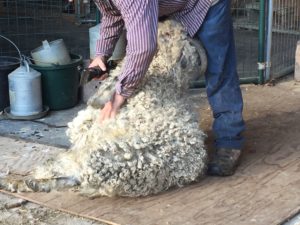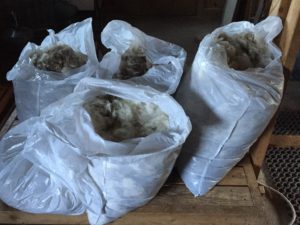After a mild winter, our goats had full, heavy fleeces that needed to be sheared off before the summer heat. With the milder than normal temperatures, they were able to put less energy into staying warm and more energy into growing longer and thicker fleeces.
The local shearer stopped by earlier in the spring to shear our goats.
Here is a quick look at the start of Ruby’s shearing this spring. He likes to start with the stomach first and then move on to the legs and back. This video shows the first few passes across Ruby’s stomach area.
Click through to see more videos and photos of the spring 2016 shearing.
Here, you can see Ruby’s side and back being sheared, with a large piece of her fleece coming off in a single piece.
The shearing went off mostly without issues for most of our goats.
However, Oz did manage to escape from the shearer and run around the adjacent pasture with his half-sheared fleece still attached and pieces of fleece flying off as we tried to chase him down and bring him back to finish the shearing process.
Here is a picture of Rascal being sheared.
Overall, we ended up with 4 and a 1/2 bags of additional mohair from the spring 2016 shearing.
Adding that to the mohair we have from fall 2015 leaves us with 7 and a 1/2 bags of raw mohair currently. Next up, we need to skirt the fiber. Skirting is the process of sorting the fiber and removing any unwanted fiber that may be stained. Skirting also helps remove hay and other debris from the fiber so the rest of the processing of the fiber is easier.
The shearing price went up to $15 per goat, so the total for the spring shearing was $105 for our 7 goats. The running total for the current stash of mohair is now up to $165 for shearing and processing costs.


